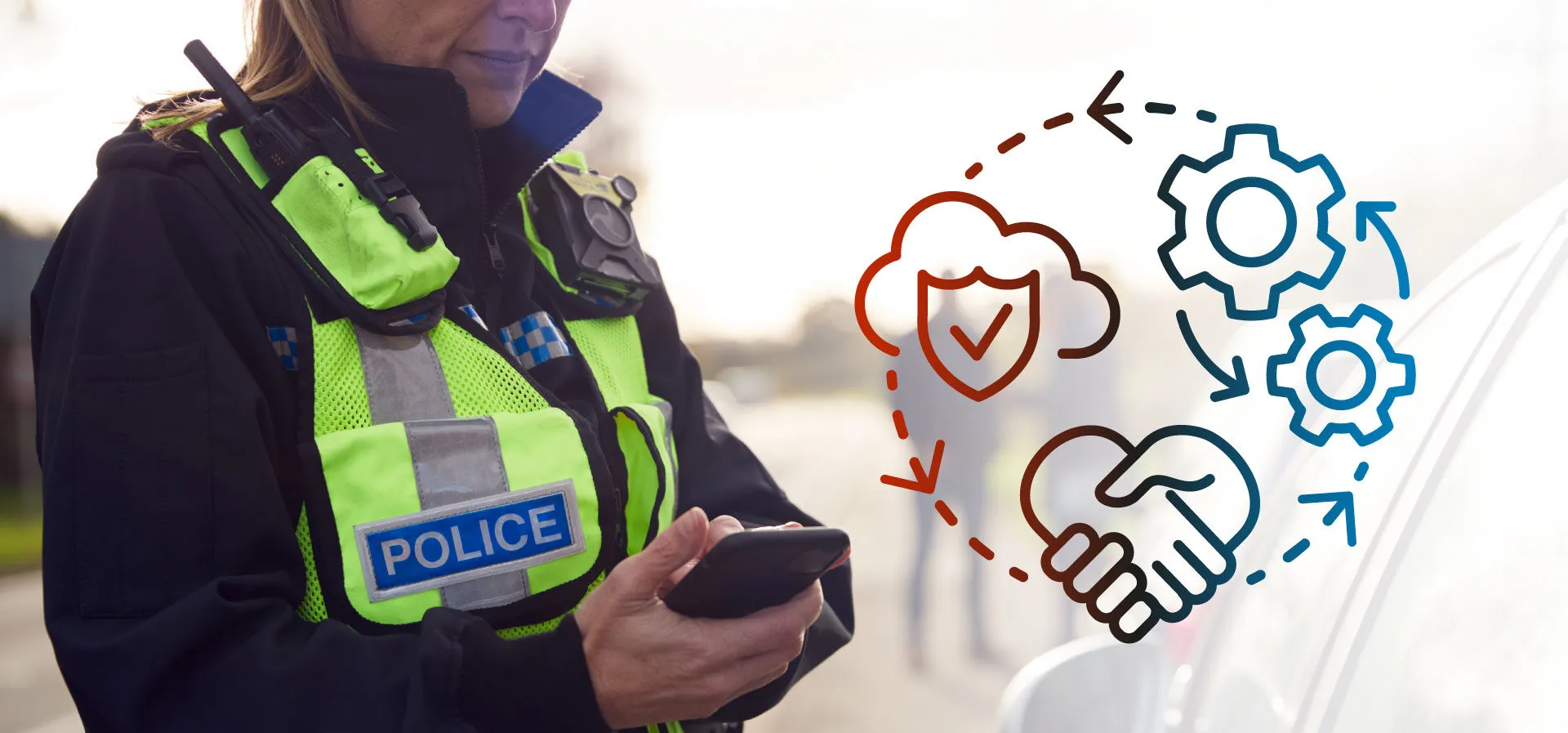By: Dr. Muhammad Rizwan Bhatti

The world has become a globalized village. The advent of technology has made communication easy and information spread far and wide in moments. There are different types of media, such as print media, electronic media, social media, digital media, and out-of-home media like billboards. These types of media are different channels through which information and entertainment are disseminated to various segments of society. Leveraging digital media in crisis communication is critical for better community engagement and effective policing to maintain law and order. Digital media comprises social media, websites, online publications, email newsletters, and mobile apps; it offers a diverse platform for spreading information immediately and interacting with the community in times of crisis and tribulations.
Crisis communication is a viable strategy to disseminate information about critical events to the media and relevant stakeholders to reduce damage and misgivings, maintain public trust, and take appropriate actions and responses. Police have to grapple with different crisis situations such as violent riots, religio-political protests, rallies, and the worst forms of terrorism. The best example is the recent bigotry incident that occurred in Sargodha. The crowd was belligerent, but the timely response of the higher hierarchy, taking stakeholders such as peace committees into confidence, and providing timely, unambiguous, accurate, and transparent information to the media helped dissolve a crisis situation that could have escalated into violent riots across the province. Moreover, the handling of the Jaranwala incident was exemplary. The issue was serious. Riots in Jaranwala city erupted due to the alleged desecration of Quranic verses. RPO Faisalabad Dr. Muhammad Abid Khan handled the crisis situation in a very judicious manner. He rushed to the site without wasting any time and involved all the stakeholders to alleviate the tense security situation. He directed his Public Relations Officer to monitor electronic, print, social, and digital media. Furthermore, he established rehabilitation centers to accommodate the vulnerable community. The rehabilitation camps were provided with healthcare facilities, food, and accommodation. He utilized digital media to avoid misinformation and disseminate timely and relevant information to the media to prevent speculations and misgivings. IGP Punjab accomplished tremendous tasks by establishing Meesaq Centers to serve the minorities at their doorstep. Meesaq Centers did remarkable work by reconciling different issues that may escalate into dangerous enmity. He leveraged social media to defuse crisis communication for better community engagement.
Digital media serves as a critical tool in crisis communication due to its immediacy, wide reach, and interconnectivity. Unlike traditional media, digital platforms allow for real-time updates and direct interaction with the audience, which is vital during a crisis. Social media platforms like Twitter, Facebook, and Instagram enable organizations to disseminate timely information, correct misinformation, and engage with the community directly. Websites and mobile apps provide a centralized hub for detailed updates, resources, and emergency contact information. Email newsletters ensure that important updates reach stakeholders directly in their inboxes.
Crisis communication commences long before a crisis happens. The police department should formulate a comprehensive crisis communication plan that includes an effective digital media strategy. The crisis communication plan should identify key digital platforms, designate spokespersons, and outline ways and means for the speedy dissemination of information. No one knows when a crisis situation will emerge. So, it is necessary to engage the community through the usage of social media, print, and electronic media by giving them information about the good work done by the police, the mechanism to combat crime and criminals, and sharing information about the services being rendered to the public for their convenience and integrity. There are diverse ways to engage the community, such as holding open courts, making awareness messages, and effectively wielding social, print, and electronic media to transmit information about the actions being taken for the protection of the life and property of citizens. This practice also precludes misinformation and unwieldy speculations on the part of the media and the public. To deal with a crisis in an appropriate manner, undoubtedly, three P’s like preparedness, promptness, and post-incident transparency play a very crucial role in avoiding any sort of speculation, misgivings, and embarrassment to the organization.
During a crisis, concise, timely, and accurate dissemination of information is of paramount importance. Police must employ digital media to impart real-time updates. Social media platforms are significantly important for ready announcements and reliable updates. It is important to ensure that all information is reliable and accurate to avoid displaying misinformation, which can aggravate the crisis. In the crisis situation, PROs serve as an “ethical compass.” Their integrity should be aboveboard and beyond reproach.
Digital media is important because of its interactivity. It allows for two-way communication. Police should proactively interact with the community by responding to questions, addressing grievances, and providing fair justice. Social media management tools can facilitate effective monitoring and prompt responses to comments and messages. This two-way communication engenders a sense of cohesive community and trust, reassuring the citizens that their issues and grievances are being heard and addressed accordingly.
Utilizing various forms of multimedia content can enhance the effectiveness of crisis communication. Furthermore, appropriate usage of multimedia content increases the efficacy of crisis communication. Additionally, infographics, videos, and images can transmit intricate information more vividly than text alone. For example, visual guides on safety procedures or evacuation routes can be more easily understood and remembered. Moreover, multimedia content has the capacity to reach a wider audience.
However, consistent and transparent communication is necessary in times of crisis. The hierarchy of police must ensure that all digital communication is coherent on diverse platforms to avoid confusion and dichotomy of thought. Clarity about the pervasive situation helps to dispel misgivings and maintain the credibility of an institution. Regular updates assure the public that the situation is being monitored continuously and no aggravation is in sight.
Notables, influencers, and community leaders can play a crucial role in diluting the volatile situation with their presence and word of trust in the police. Their narrative about the good efforts of the police can neutralize the propaganda of miscreants and disgruntled elements. Therefore, robust collaboration and communication with important luminaries of society who have a strong presence and influence on online digital media platforms can help spread information speedily and also give credibility to the message put forward by the police. Moreover, their messages can also help prevent misinformation and provide actual facts to the public and followers of any religio-political organization.
Nonetheless, along with the dissemination of correct information, perpetual monitoring of digital and electronic media channels is critical for vibrant crisis communication. It is essential to track public sentiments on social media to avert any mischief and to foresee impending dangerous events. In this respect, proper feedback mechanisms through conducting surveys and polls can help discern the concerns of the community and the necessary information required for understanding the situation. If the response to managing the crisis is effective and the disaster has been diminished, then it would be essential to make an elaborate assessment of the crisis situation.
Post-crisis communication is crucial as the simmering and smoldering situation can again become a conflagration. Police hierarchy through its PROs should continue to provide fresh updates about the emerging situation and rehabilitation efforts. Again, if we take the case study of the Jaranwala incident, RPO Faisalabad Dr. Muhammad Abid Khan kept updating the media and relevant stakeholders about the rehabilitation efforts for the forlorn Christian community. The apprehension of the main accused was shared with the press and media. The modus operandi of the involved miscreants was also shared with the public through social media. The public was told about the real facts of the incident. So, post-crisis engagement is essential to obviate the possibility of confusion and spreading false rumors. Moreover, the public should know about the recovery efforts of the police and administration to mitigate the crisis impact in society. In addition, the appreciation of community involvement in the elimination of the crisis should also be acknowledged at all forums.
Leveraging digital media in crisis communication for better policing and gaining public trust is essential to end the crisis and placate grievances. The immediacy, promptness, access, and interactivity of digital platforms render them unparalleled tools for spreading information, dovetailing with the community, and managing public perception during crises. However, proactive planning, real-time information dissemination, managing two-way communication, using multimedia content, maintaining consistency and transparency, managing influencers, overseeing feedback, and perpetual post-crisis communication can effectively manage crises and build stronger, more resilient communities. Leveraging social media for effective crisis communication is essential to deal with any crisis situation and engage the public at a larger level. This act will help manage public grievances and enlighten the audience about the steps being taken for the redressal of the crisis
The writer is a Ph.D in Political Science from GCUF and a Police officer. He can be reached at [email protected]











